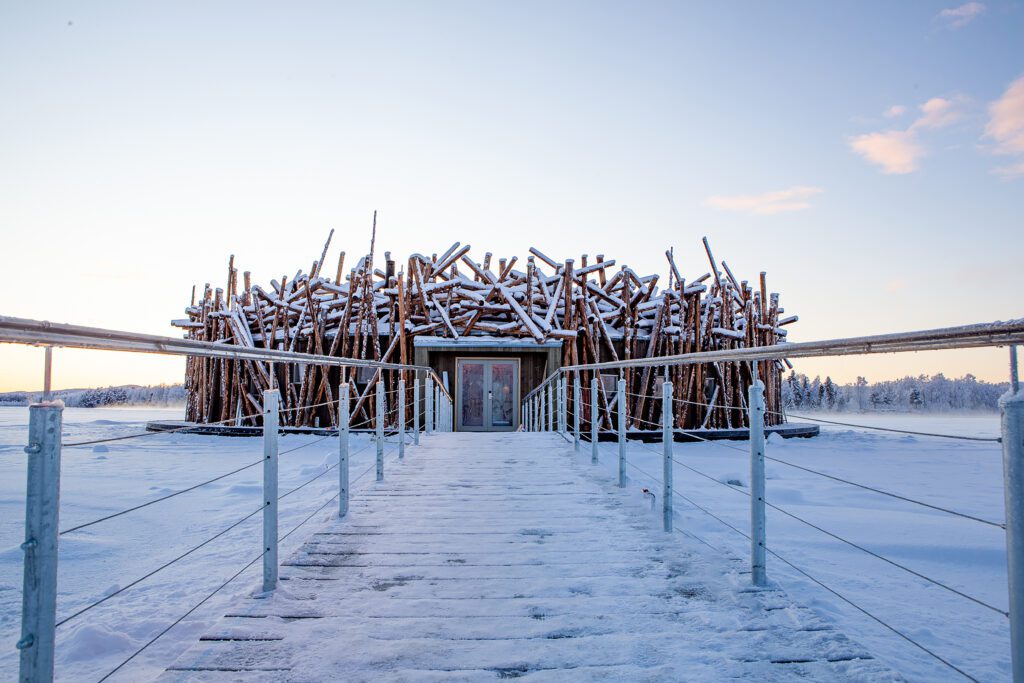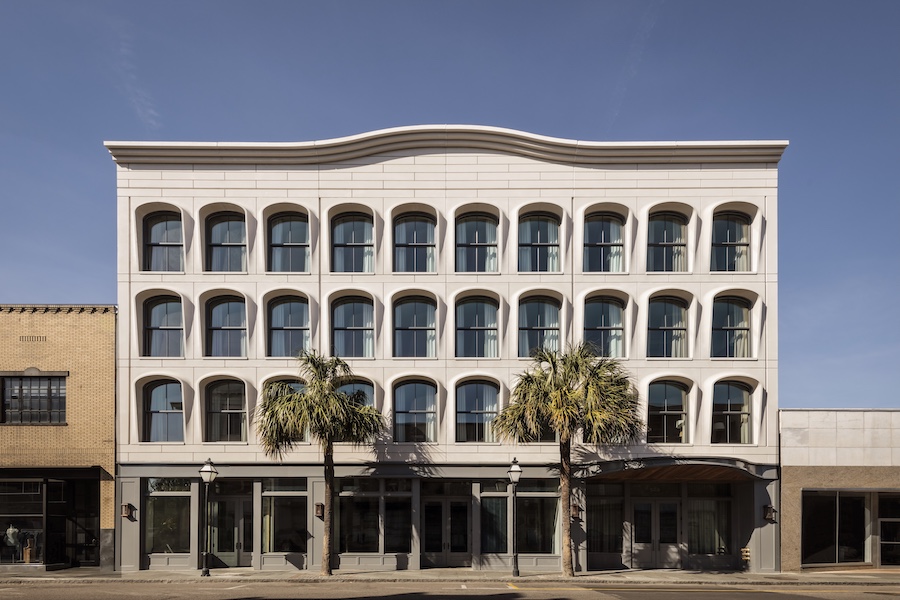Artic Bath
A floating spa and hotel comes to life in Sweden’s arctic region
Words by: Alicia Hoisington

Sometimes an off-the-cuff idea, which on first thought might seem impossible, turns into a new concept that spans beyond a dream—or in Arctic Bath’s case, an offhand joke at a party. “The original idea came from [developer] Per-Anders Eriksson during dinner for the opening of [Sweden’s] Treehotel in 2010,” says AnnKathrin Lundqvist, partner at Arctic Bath AB. “Sitting next to him at the table was Bertil [Harström],” a designer of the floating structure, along with Johan Kauppi, co-founder of Swedish design firm Kauppi & Kauppi. “Per-Anders turned to Bertil and asked what he thought about the idea of a floating sauna and a cold bath on the Lule River.” Harström and Kauppi came back with the original drawings of the main structure for Arctic Bath in 2013. Hotel rooms were added to the concept a couple of years later, and in January the floating structure opened its doors to guests.

From what started as a fun idea drawn on the back of a napkin over drinks, the challenge was to make it a functional, attractive space that can cater to guests across multiple seasons. The solution: make use of the surroundings in the northern Swedish village of Harads. The buoyant part of the hotel that includes the centerpiece, circular cold bath—as well as six guestrooms and restaurant—is constructed from Swedish wood plucked from the area, with pontoons made of floating concrete. The structure wafts during the summer and freezes into the ice during the winter.

Read more from Boutique Design’s Spring 2020 issue.
“The concept is based on our experience with the big forests up in the north and also the tradition of transporting timber logs along the rivers,” says Harström. “The design inspiration was a logjam, where timber logs get stuck in the rapid part of the river. That piece of history sparked the idea for a modern spa.” He adds that the materials allow the structure to blend in with its watery site—a river that was once part of the logging transport system.

While the spa rides on the water, the project also includes six additional landlubbing cabins designed by Lundqvist. To keep the natural theme real, the cabins are anchored by Swedish steel poles to protect the flora and soil below. Made from local pine trees sourced from the surrounding forest, the buildings’ exteriors are treated with oils and iron oxide, and all wood decks are waterproofed with tar. Interiors are no different, employing stone, leather, and an abundance of wood for a sustainable, easy-luxury vibe.

Photos: Anders Blomqvist, Daniel Holmgren
Projects:
Artic Bath
A floating spa and hotel comes to life in Sweden’s arctic region
Sometimes an off-the-cuff idea, which on first thought might seem impossible, turns into a new concept that spans beyond a dream—or in Arctic Bath’s case, an offhand joke at a party. “The original idea came from [developer] Per-Anders Eriksson during dinner for the opening of [Sweden’s] Treehotel in 2010,” says AnnKathrin Lundqvist, partner at Arctic Bath AB. “Sitting next to him at the table was Bertil [Harström],” a designer of the floating structure, along with Johan Kauppi, co-founder of Swedish design firm Kauppi & Kauppi. “Per-Anders turned to Bertil and asked what he thought about the idea of a floating sauna and a cold bath on the Lule River.” Harström and Kauppi came back with the original drawings of the main structure for Arctic Bath in 2013. Hotel rooms were added to the concept a couple of years later, and in January the floating structure opened its doors to guests.

From what started as a fun idea drawn on the back of a napkin over drinks, the challenge was to make it a functional, attractive space that can cater to guests across multiple seasons. The solution: make use of the surroundings in the northern Swedish village of Harads. The buoyant part of the hotel that includes the centerpiece, circular cold bath—as well as six guestrooms and restaurant—is constructed from Swedish wood plucked from the area, with pontoons made of floating concrete. The structure wafts during the summer and freezes into the ice during the winter.

Read more from Boutique Design’s Spring 2020 issue.
“The concept is based on our experience with the big forests up in the north and also the tradition of transporting timber logs along the rivers,” says Harström. “The design inspiration was a logjam, where timber logs get stuck in the rapid part of the river. That piece of history sparked the idea for a modern spa.” He adds that the materials allow the structure to blend in with its watery site—a river that was once part of the logging transport system.

While the spa rides on the water, the project also includes six additional landlubbing cabins designed by Lundqvist. To keep the natural theme real, the cabins are anchored by Swedish steel poles to protect the flora and soil below. Made from local pine trees sourced from the surrounding forest, the buildings’ exteriors are treated with oils and iron oxide, and all wood decks are waterproofed with tar. Interiors are no different, employing stone, leather, and an abundance of wood for a sustainable, easy-luxury vibe.

Photos: Anders Blomqvist, Daniel Holmgren


